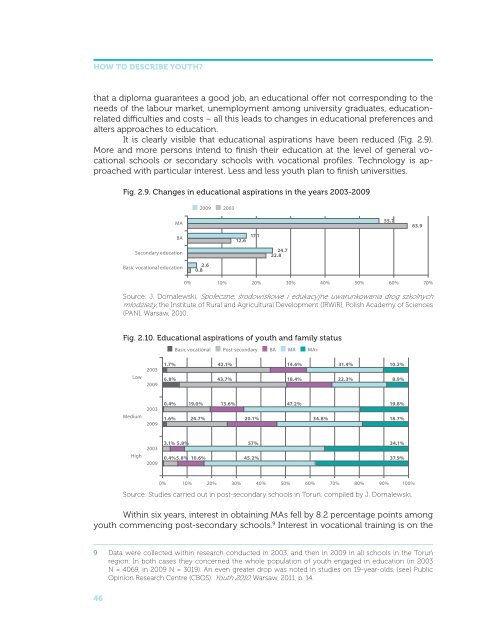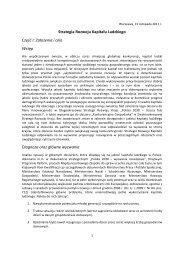How to describe youth? Crucial life issues, aspirations, expectations
How to describe youth? Crucial life issues, aspirations, expectations
How to describe youth? Crucial life issues, aspirations, expectations
Create successful ePaper yourself
Turn your PDF publications into a flip-book with our unique Google optimized e-Paper software.
<strong>How</strong> <strong>to</strong> <strong>describe</strong> <strong>youth</strong>?<br />
that a diploma guarantees a good job, an educational offer not corresponding <strong>to</strong> the<br />
needs of the labour market, unemployment among university graduates, educationrelated<br />
difficulties and costs – all this leads <strong>to</strong> changes in educational preferences and<br />
alters approaches <strong>to</strong> education.<br />
It is clearly visible that educational <strong>aspirations</strong> have been reduced (Fig. 2.9).<br />
More and more persons intend <strong>to</strong> finish their education at the level of general vocational<br />
schools or secondary schools with vocational profiles. Technology is approached<br />
with particular interest. Less and less <strong>youth</strong> plan <strong>to</strong> finish universities.<br />
Fig. 2.9. Changes in educational <strong>aspirations</strong> in the years 2003-2009<br />
2009<br />
2003<br />
MA<br />
BA<br />
Secondary education<br />
Basic vocational education<br />
55.7<br />
63.9<br />
12.6 17.1<br />
0.8 2.6 22.8 24.7<br />
0%<br />
10%<br />
20%<br />
30%<br />
40% 50% 60%<br />
70%<br />
Source: J. Domalewski, Społeczne, środowiskowe i edukacyjne uwarunkowania drog szkolnych<br />
młodzieży, the Institute of Rural and Agricultural Development (IRWiR), Polish Academy of Sciences<br />
(PAN), Warsaw, 2010.<br />
Fig. 2.10. Educational <strong>aspirations</strong> of <strong>youth</strong> and family status<br />
Basic vocational<br />
Post-secondary<br />
BA<br />
MA<br />
MA+<br />
Low<br />
2003<br />
2009<br />
1.7% 42.1%<br />
14.6% 31.4% 10.2%<br />
6.8% 43.7%<br />
18.4% 22.3% 8.9%<br />
Medium<br />
2003<br />
2009<br />
0.4% 19.0% 13.6% 47.2% 19.8%<br />
1.6%<br />
24.7%<br />
20.1% 34.8% 18.7%<br />
High<br />
2003<br />
2009<br />
3.1% 5.8%<br />
57%<br />
34.1%<br />
0.4% 5.8% 10.6% 45.2%<br />
37.9%<br />
0% 10% 20% 30% 40% 50% 60% 70% 80% 90% 100%<br />
Source: Studies carried out in post-secondary schools in Toruń, compiled by J. Domalewski.<br />
Within six years, interest in obtaining MAs fell by 8.2 percentage points among<br />
<strong>youth</strong> commencing post-secondary schools. 9 Interest in vocational training is on the<br />
9 Data were collected within research conducted in 2003, and then in 2009 in all schools in the Toruń<br />
region. In both cases they concerned the whole population of <strong>youth</strong> engaged in education (in 2003<br />
N = 4069, in 2009 N = 3019). An even greater drop was noted in studies on 19-year-olds, [see] Public<br />
Opinion Research Centre (CBOS): Youth 2010, Warsaw, 2011, p. 14.<br />
46







